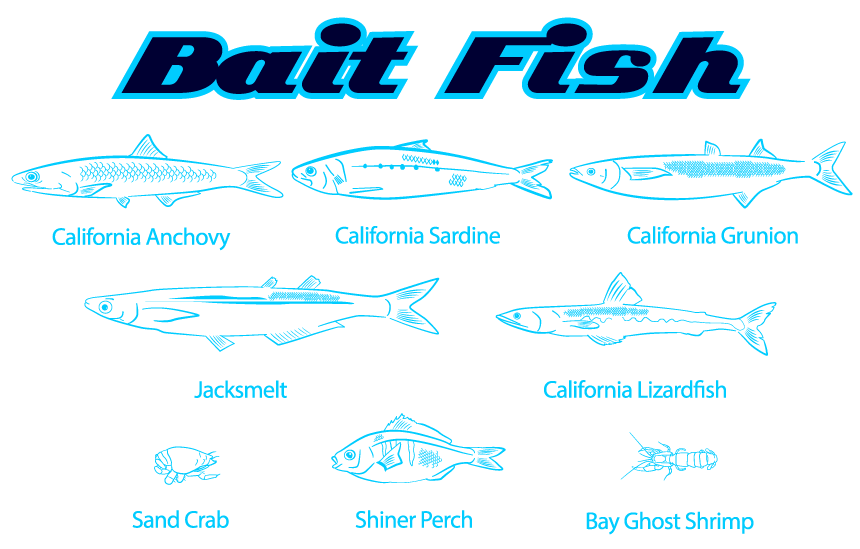 |
| |
| The baitfish for California Halibut(Paralichthys Californicus)
The halibut is a predatory ambush fish. Juvenile halibut sometime feed on bristle worm (eunicidae), but once they reach a certain size, they mainly feed on shell fish, shrimp, anchovy, sardine, smelt, shiner perch, CA lizard fish and squid. Since they feed mainly on sight and by ambush, water clarity plays a big role in the success of targeting halibut. Halibut anglers don't need to be as conscious of match-the-bait as sea bass, but when you are targeting larger and smarter models or when you are trying to entice bites when the fish are inactive, being conscious of match-the-bait tends to get a better response. |
 |
 |
| California Anchovy(Engraulis mordax)is the prey of many marine fish such as halibut and sea bass. Anchovy is a baitfish that is likely to congregate in shore and in the surf from spring to fall. The anchovy swims near the surface creating bait balls that halibut tend to be more conscious of. Since anchovies swim fast, they tend to respond better to fast movements and faster retrieves when they are inshore. |
| |
 |
 |
| California Sardine(Sardinops sagax)is the most common bait fish. Sardines come in shore and in the surf from spring to fall and swim in large schools. They often swim from the surface to the middle of the water. Sardines are fast swimmers and often swim at high speed. Fast retrieving hard baits is the most effective way to catch halibut when they are feeding on sardine. It is good practice to have at least one sardine pattern in your tackle. |
| |
 |
 |
| California Grunion(Leuresthes tenuis)spawn in schools on the beach during high tide of the full moon in the spring and summer locally called grunion runs. When targeting halibut that come to the surface to feed on grunion you want to use a lure that can swim in a range from thesurface to around 3 feet. You can check the grunion run schedules HERE |
| |
 |
 |
| Jacksmelt(Atherinopsis californiensis)are coastal shallow water fish that are preyed upon by halibut year round. Their main migratory range ranges from 3 to 5 feet, but if the Halibut are feeding on the shallow water Smelt, they will respond better to lures targeting around 3 to 6 feet. |
| |
 |
 |
| California Lizardfish(Synodontidae)are another prey favored by halibut. They prefer to live in sandy bottoms and camouflage themselves. If you want to catch a flatfish that feeds on lizardfish, use a lure that targets the range from near the bottom to the middleof the water. |
| |
 |
 |
| Sand Crab(Emerita)are another great bait in the surf. They burrow in the sand in the wash zones. Many targeted fish species congregate in the feeding zone. Best rig is a Carolina rig and dragging the sand crab in the surf. |
| |
 |
 |
YELLOWFIN CROAKER
The Yellowfin Croaker feeds mainly on crustaceans such as shrimp and is found in coastal areas where there is a lot of bait. In sandy areas, the Yellowfin Croaker feeds on crustaceans that appear in the waves, so it can be caught in the surf. In addition to targeting them mainly with lures that imitate crustaceans such as worms, small plugs and spoons can also produce reaction bites. Long bill minnows knocking on the bottom are effective lures. |
| |
 |
 |
| Shiner Perch(Cymatogaster aggregata)is a common surfperch found in estuaries, lagoons, and coastal streams along the Pacific coast from Alaska to Baja California. Shiners are also great bait around eelgrass beds in bays, pier and dock piling and are often attracted by halibut that feed on them. Their main migratory range ranges from surface to 6 feet, use a lipless crank-type lures that can target the middle range of the strike zone for good results. |
| |
 |
 |
| Bay Ghost Shrimp(Neotrypaea californiensis)is a small shrimp that lives in sandy coastal areas in bays. If you want to catch halibut that are feeding on ghost shrimp, use a lure that can be retrieved slowly near the bottom to stimulate their appetite. |
| |
 |
| |
| |
|
Copyright © LUCKY CRAFT, INC. All Rights Reserved. |
|



















